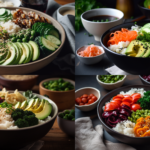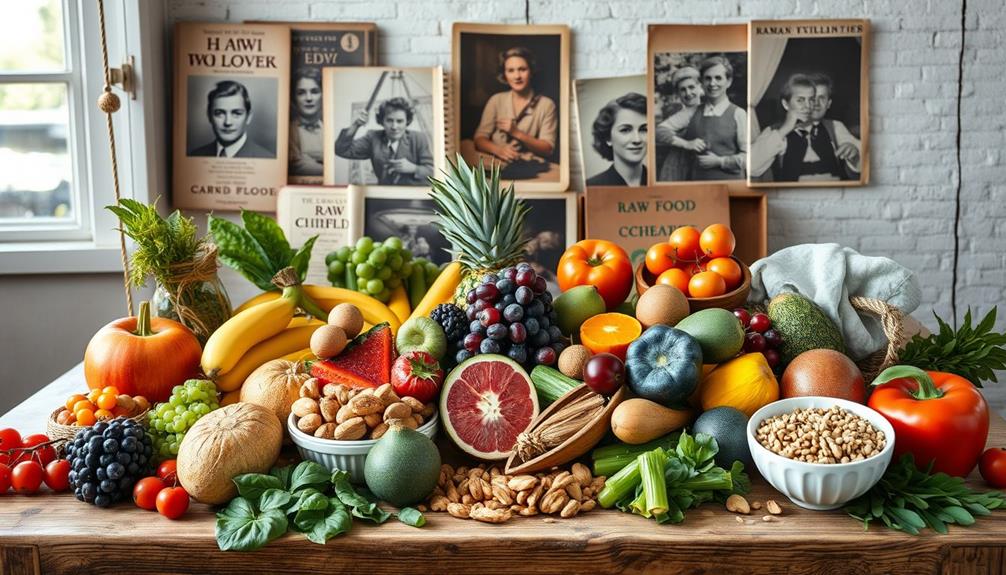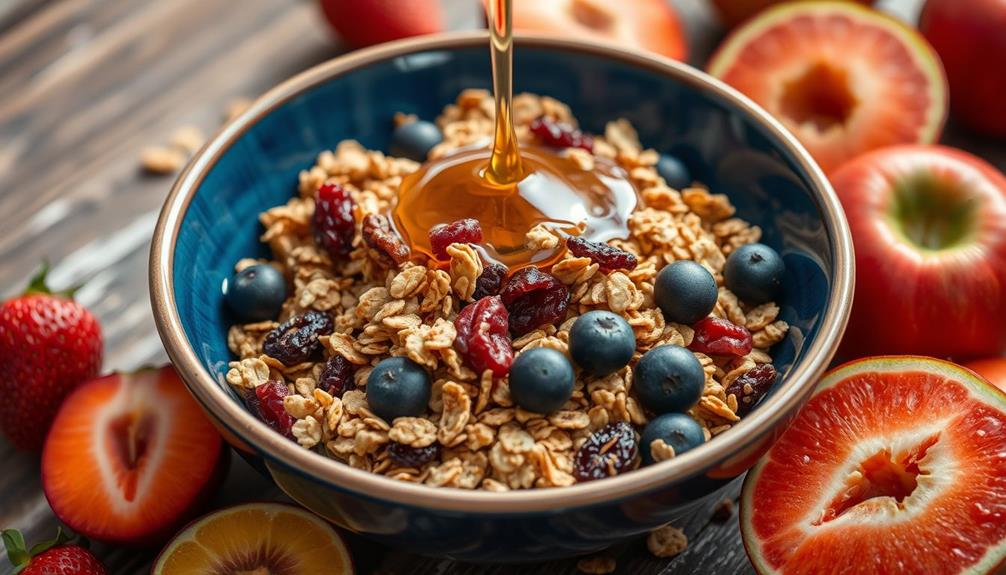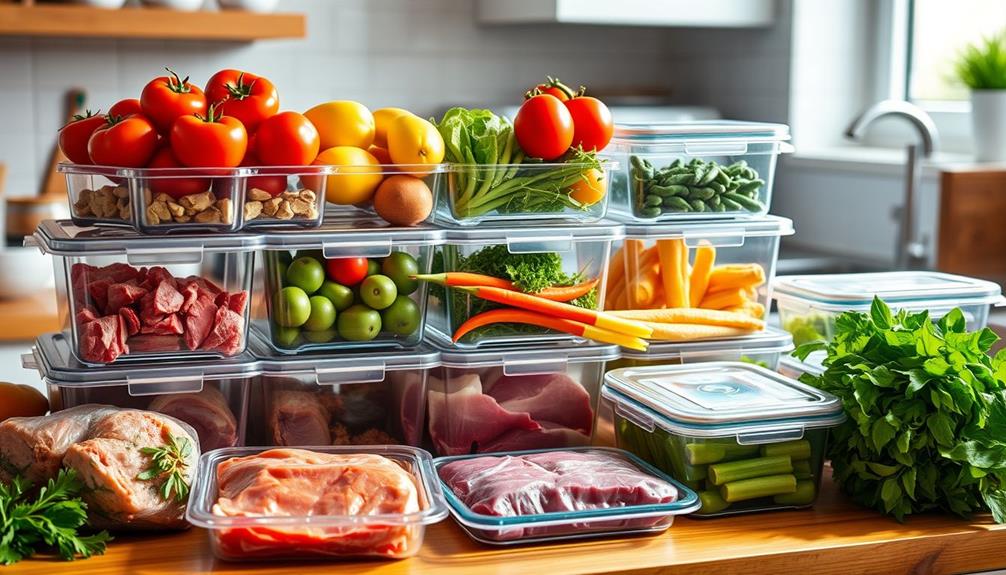Yes, you can eat sushi on a raw food diet, but pay attention to what you include. Stick to raw vegan sushi, which uses fresh vegetables and nori without any animal products. If you opt for sushi that includes raw fish, make certain it's sushi-grade and properly frozen to eliminate harmful parasites. Always source your fish from reputable suppliers to avoid foodborne illnesses. Remember to avoid cooked rice and check that all ingredients are raw. With a few simple adjustments, sushi can fit perfectly into your raw food lifestyle, and there's even more to explore about this delicious option.
Key Takeaways
- Raw vegan sushi is a suitable option, featuring fresh vegetables and nori, while avoiding all animal products.
- If consuming raw fish sushi, ensure it is sushi-grade and sourced from reputable suppliers to mitigate food safety risks.
- Sushi rice is not compatible with a raw food diet; consider alternatives like shredded jicama for texture.
- Proper freezing of fish at -4°F for a week is essential to eliminate parasites before consumption.
- Incorporating colorful vegetables in sushi enhances nutrient density and health benefits, supporting a raw food lifestyle.
Understanding Raw Food Diets
When you explore raw food diets, you'll find they focus on unprocessed, whole foods that aren't heated above 104-118°F (40-48°C) to keep nutrients and enzymes intact. These diets can vary considerably, with options like the raw vegan diet that excludes all animal products, as well as raw omnivorous diets that include raw animal products, such as raw fish.
Notably, while raw fruits and vegetables are staples, incorporating items like celery juice can enhance the diet's antioxidant properties and promote hydration, making it a popular choice among raw food enthusiasts health benefits of celery juice.
You'll typically consume raw fruits and vegetables, nuts, seeds, and sprouted grains, while processed items and cooked proteins are off-limits. This emphasis on uncooked foods underscores the potential health benefits, including improved digestion and increased energy levels.
Preparation techniques like soaking, sprouting, and dehydrating enhance the digestibility and nutrient absorption of these raw foods.
However, it's crucial to be aware of nutrient deficiencies that can arise from a raw food diet. You might struggle to get adequate protein, vitamin B-12, and iron, which often necessitates careful planning and potential supplementation.
Balancing these elements is key to enjoying the benefits of a plant-based diet while maintaining your overall health.
Sushi and Food Safety
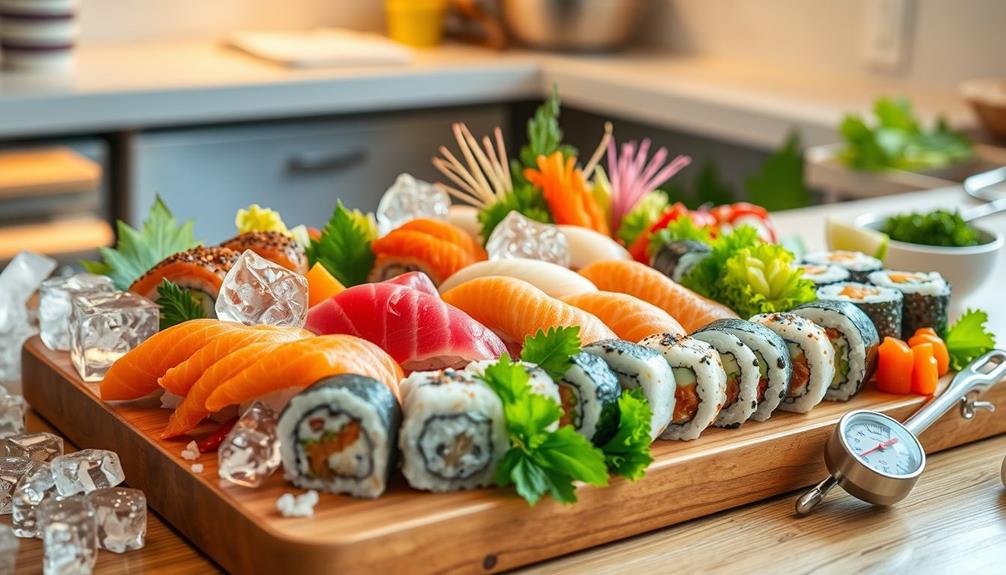
Sushi lovers often face the challenge of ensuring food safety when indulging in raw seafood. Consuming sushi comes with risks, as raw seafood can harbor parasites and bacteria that lead to foodborne illnesses.
To mitigate these risks, it's vital to source your sushi from reputable suppliers who adhere to safety standards. Sushi-grade fish should be deep-frozen at -4°F for nearly a week to kill potential parasites before consumption. Additionally, understanding the importance of selecting the right cold medication can help you identify symptoms that might arise after eating raw seafood, as certain foodborne illnesses can mimic cold symptoms.
If you're concerned about food safety, consider ceviche as a safer alternative. This dish uses acidic ingredients like lime or lemon to denature proteins and kill bacteria, making it a popular choice for those wary of raw seafood.
However, if you're immunocompromised, pregnant, or have young children, you should exercise extra caution when consuming sushi or any raw seafood due to your heightened susceptibility to infections.
Ultimately, ensuring food safety is essential when enjoying sushi. By focusing on careful sourcing and being mindful of your health status, you can indulge in sushi while minimizing risks associated with raw seafood.
Types of Sushi Options
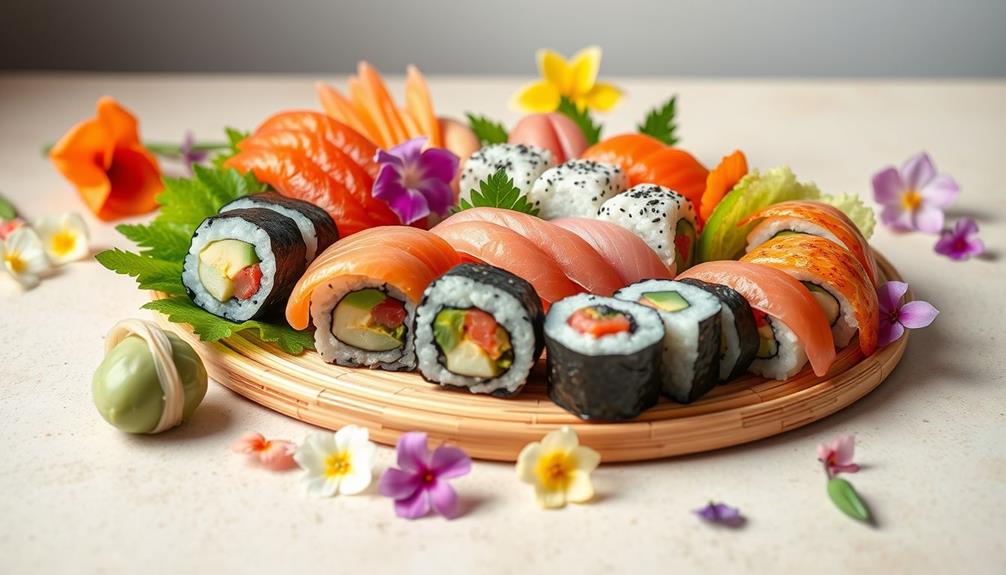
Exploring the various types of sushi options can enhance your dining experience, especially if you're following a raw food diet. One great choice is raw vegan sushi, which uses fresh vegetables and nori sheets, avoiding all animal products. Ingredients like cucumber, avocado, and jicama serve as a rice substitute, creating a delicious and nutritious meal.
Incorporating fresh herbs can also elevate flavors, much like how essential oils for hair growth promote health in different ways.
While traditional sushi often includes cooked components, these aren't suitable for a strict raw food diet. Instead, focus on customization by incorporating a variety of fresh vegetables, herbs, and seasonings to create unique flavors that align with raw food principles.
When selecting nori sheets, make sure they're raw, as roasted varieties containing oil should be avoided.
Here are some options to contemplate:
- Raw Vegan Sushi Rolls: Made with your favorite veggies and nori.
- Sushi Bowls: Layered raw ingredients in a bowl for easy eating.
- Sushi Hand Rolls: Nori wrapped around fresh fillings for a handheld treat.
- Sushi Salad: Tossed ingredients with sushi flavors for an invigorating option.
These sushi options not only provide health benefits but also allow for creativity in your raw food journey!
Nutritional Benefits of Sushi
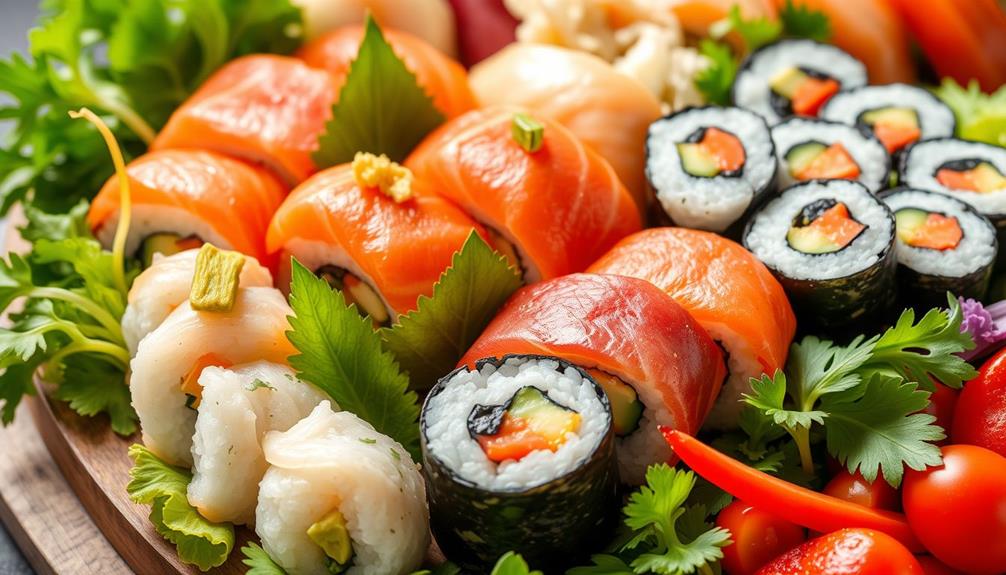
When you enjoy sushi, you're treating yourself to a variety of nutrient-rich ingredients. The fresh fish and vegetables provide essential vitamins and omega-3 fatty acids, which are great for your heart health.
Additionally, sushi often incorporates ingredients that promote digestive health due to their high fiber content, which can also support the benefits of raw food.
Plus, the combination of these ingredients can help enhance your overall well-being.
Nutrient-Rich Ingredients
Delving into the world of sushi reveals a treasure trove of nutrient-rich ingredients that can greatly boost your health. When you choose sushi made with raw vegetables, you're not just enjoying a delicious meal; you're also consuming a variety of essential nutrients. The combination of colorful veggies enhances the antioxidant content, helping combat oxidative stress and inflammation.
Additionally, understanding the mechanics of how sushi is prepared can enhance your dining experience, similar to mastering different brewing methods for coffee.
Here are some nutrient-dense components to reflect upon:
- Cucumber: Invigorating and hydrating, it adds essential vitamins.
- Avocado: Packed with monounsaturated fats, this creamy fruit supports heart health and lowers bad cholesterol.
- Nori: This seaweed wrap is an excellent source of iodine and fiber, promoting thyroid function and digestive health.
- Jicama: As a rice substitute, it reduces carbs while boosting fiber intake, contributing to satiety and better digestion.
Incorporating these ingredients into your sushi not only makes your meal tasty but also enriches it with healthy fats, fiber, and essential nutrients.
Omega-3 Fatty Acids
Sushi is more than just a delightful culinary experience; it's a powerhouse of omega-3 fatty acids, especially when you choose varieties that include fatty fish like salmon and mackerel. These fatty fish are essential for heart health and can help reduce inflammation in your body, promoting improved cardiovascular health.
A typical serving of sushi with fish can provide around 1,000 to 1,500 milligrams of omega-3s, greatly contributing to the recommended daily intake of 250 to 500 milligrams. If you prefer plant-based options, look for sushi that includes ingredients like avocado and chia seeds. While these also contain omega-3s in the form of alpha-linolenic acid (ALA), your body converts ALA to EPA and DHA less efficiently.
Here's a quick comparison of omega-3 sources in sushi:
| Type of Sushi | Omega-3 Content (mg) | Source |
|---|---|---|
| Salmon Nigiri | 1000 – 1500 | Fatty Fish |
| Mackerel Sashimi | 1500 | Fatty Fish |
| Avocado Roll | 200 | Plant-Based (ALA) |
Incorporating omega-3-rich sushi into your diet can lead to a healthier heart and lower inflammation levels.
Risks of Eating Raw Fish
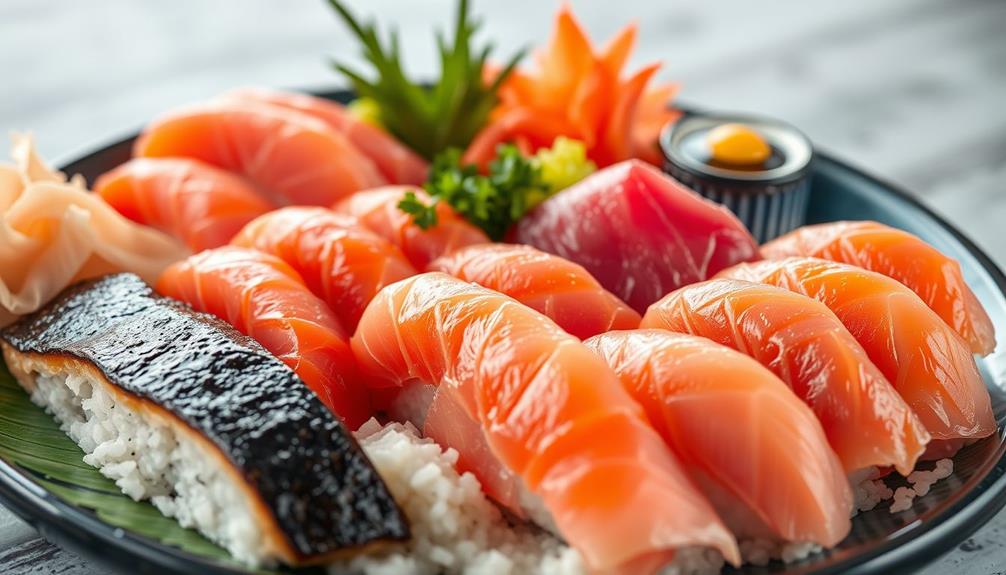
When you choose to eat raw fish, you expose yourself to the risk of foodborne illnesses like Salmonella and Vibrio infections.
It's essential to source your fish from reputable suppliers who prioritize food safety, as even sushi-grade fish can harbor harmful bacteria.
Regular screenings like mammography guidelines can help detect potential health issues, but it's equally important to be aware of the risks associated with consuming raw fish.
If you're in a vulnerable group, such as pregnant women or the elderly, the stakes are even higher.
Foodborne Illnesses Risk
How safe is it to indulge in raw fish? While many enjoy sushi, it's important to be aware of the potential risks associated with foodborne illnesses. Raw fish can harbor parasites and harmful bacteria that might lead to serious health issues.
Additionally, understanding the basics of common financial terms can help you make informed decisions about spending on dining experiences.
To keep yourself safe, consider these key points:
- Verify you choose sushi-grade fish, which has been frozen at -4°F for about seven days to eliminate parasites.
- Be cautious if you have a compromised immune system, as you're more susceptible to infections like Vibrio vulnificus.
- Watch out for scombroid poisoning, which can occur from improperly stored fish that may produce histamine.
- Always practice good food safety practices, including checking hygiene standards at establishments serving raw fish.
Sourcing Quality Fish
Finding quality fish is essential for anyone considering raw consumption. To minimize health risks, you should prioritize sourcing sushi-grade fish that has been handled properly. Here's a quick overview to guide you:
| Criteria | What to Look For | Why It Matters |
|---|---|---|
| Fish Freshness | Clean, ocean-like smell | Guarantees safety for raw consumption |
| Sourcing | Reputable suppliers | Reduces risk of foodborne illnesses |
| Sustainability | Sustainably caught | Supports responsible fishing practices |
When purchasing fish, verify that it's been deep-frozen at -4°F for about a week to eliminate parasites. You also need to ask about local health regulations related to raw seafood. Be aware that certain bacteria, like Vibrio vulnificus, can lead to severe infections, especially for immunocompromised individuals. Always confirm that your fish meets these safety standards before enjoying it raw. By focusing on these factors, you'll elevate your sushi experience while keeping health concerns at bay.
Preparing Sushi at Home
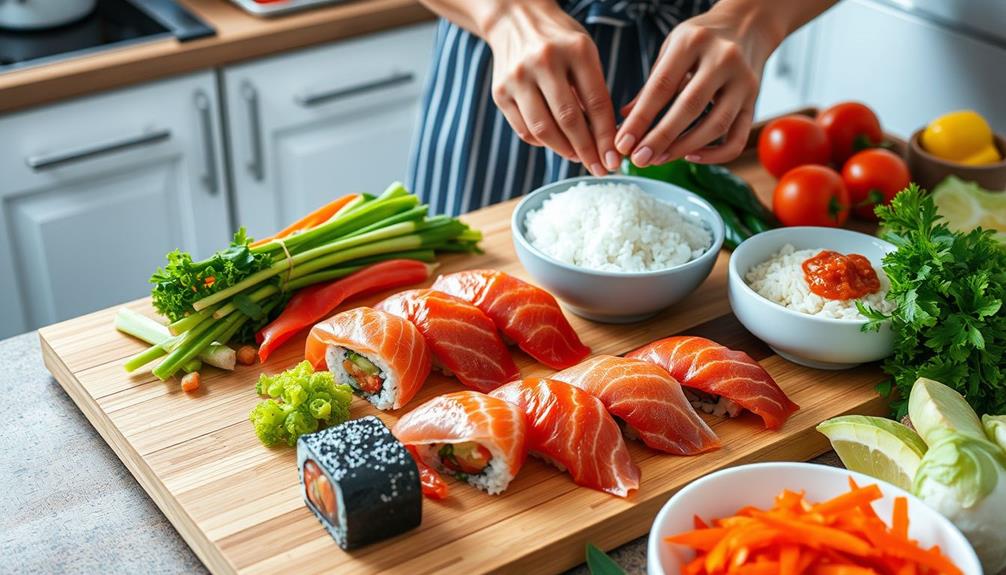
Preparing sushi at home on a raw food diet opens up a world of fresh flavors and creative possibilities. By using raw ingredients, you can craft delicious sushi that fits your dietary needs. Start by avoiding cooked items like traditional sushi rice and instead, use shredded jicama as a crunchy rice substitute. Incorporating proper diet tips for your meals can enhance the overall nutritional value of your sushi.
- Spread mashed avocado on nori sheets for creaminess.
- Layer jicama rice and thinly sliced vegetable fillings like cucumber, bell peppers, and sprouts.
- Roll the sushi tightly with a bamboo mat to maintain shape.
- Chill for 5-10 minutes before slicing into bite-sized pieces.
This method not only keeps your sushi nutritious but also allows you to customize it to your liking. The combination of textures and flavors will make your sushi both satisfying and visually appealing.
Experiment with different vegetable fillings and enjoy the vibrant colors and tastes that a raw food diet can offer. With a little practice, you'll find making sushi at home isn't only fun but a great way to incorporate healthy, raw ingredients into your meals.
Happy rolling!
Making Informed Choices
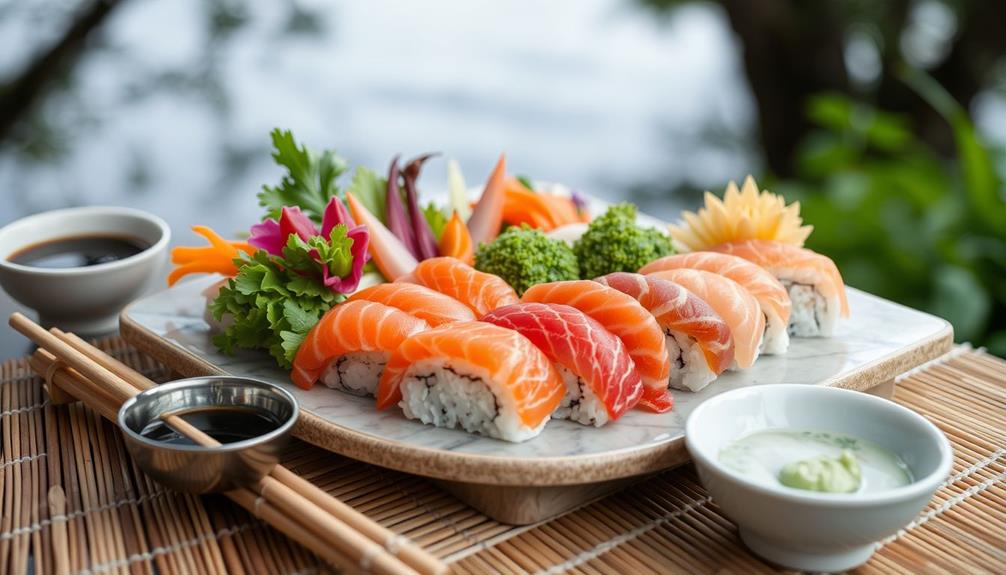
Making informed choices is vital when you're diving into sushi on a raw food diet. You'll want to make certain that every ingredient, from the seaweed to the vegetables, is raw and unprocessed. This means avoiding cooked rice or roasted nori sheets. When it comes to raw fish, sourcing sushi-grade seafood from reputable providers is essential. This fish should be frozen at -4°F for nearly a week to kill any parasites, aligning with food safety standards.
To help you navigate your sushi options, here's a quick reference table:
| Choice | Raw Food Diet Compatible | Food Safety Tip |
|---|---|---|
| Sushi-grade fish | Yes | Make certain it's properly frozen |
| Cooked rice | No | Avoid for raw food diets |
| Raw vegan sushi | Yes | Use fresh veggies and jicama |
| Rinsed fruits/veggies | Yes | Rinse to reduce contamination |
Frequently Asked Questions
Is Raw Sushi Good for a Diet?
Raw sushi can be great for your diet. It's packed with fresh vegetables and healthy fats, keeping calories low while providing essential nutrients. Just make sure you choose high-quality ingredients to maximize health benefits. One way to enjoy the benefits of raw sushi is by creating a deconstructed vegetable sushi bowl. Simply layer sushi rice with an assortment of fresh vegetables, such as cucumber, avocado, and carrots. Top it off with some nori strips and a drizzle of soy sauce for a delicious and nutritious meal. This deconstructed version allows you to customize your sushi bowl to your liking and ensures you’re getting all the health benefits of raw sushi.
What Can't You Eat on a Raw Food Diet?
Imagine a garden, vibrant and alive. On a raw food diet, you can't eat anything cooked—no meats, eggs, or refined sugars—only the pure essence of nature's bounty, untainted and untouched, nourishes your body.
What Is the Mostly Raw Food Diet?
The Mostly Raw Food Diet lets you enjoy a mix of raw foods like fruits and vegetables while allowing some cooked options. It's flexible, helping you retain nutrients and enzymes without strict adherence.
Is Raw Sushi Easy to Digest?
Imagine a garden bursting with vibrant colors; raw sushi mirrors that freshness. It's easy to digest, thanks to its high fiber and natural enzymes. You'll feel lighter and more energized as your body embraces this wholesome choice.
Conclusion
In the vibrant world of sushi, you can savor the delicate dance of flavors while staying true to your raw food diet. Just remember, choosing high-quality ingredients and practicing food safety is key to enjoying this culinary art. By preparing sushi at home, you can craft your own masterpiece, ensuring freshness and safety in every bite. So, roll with confidence, and let each piece transport you to a place where health and indulgence beautifully intertwine!




